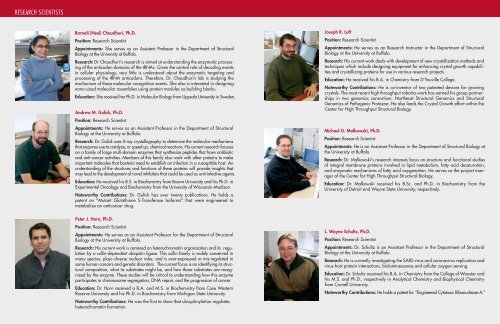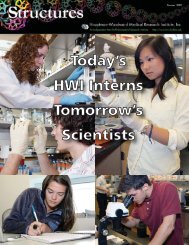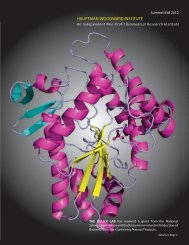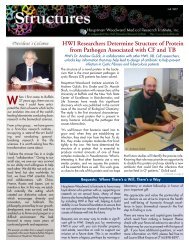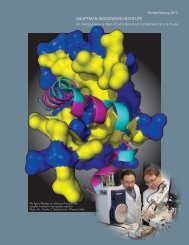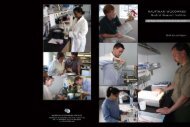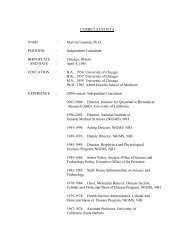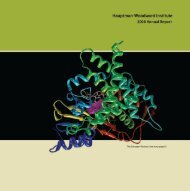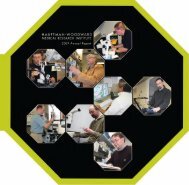Annual 2006 - Hauptman Woodward Institute - University at Buffalo
Annual 2006 - Hauptman Woodward Institute - University at Buffalo
Annual 2006 - Hauptman Woodward Institute - University at Buffalo
You also want an ePaper? Increase the reach of your titles
YUMPU automatically turns print PDFs into web optimized ePapers that Google loves.
RESEARCH SCIENTISTS<br />
Barnali (Neel) Chaudhuri, Ph.D.<br />
Position: Research Scientist<br />
Appointments: She serves as an Assistant Professor in the Department of Structural<br />
Biology <strong>at</strong> the <strong>University</strong> <strong>at</strong> <strong>Buffalo</strong>.<br />
Research: Dr Chaudhuri's research is aimed <strong>at</strong> understanding the enzym<strong>at</strong>ic processing<br />
of the anticodon domains of the tRNAs. Given the central role of decoding events<br />
in cellular physiology, very little is understood about the enzym<strong>at</strong>ic targeting and<br />
processing of the tRNA anticodons. Therefore, Dr. Chaudhuri’s lab is studying the<br />
mechanism of these molecular recognition events. She also is interested in designing<br />
nano-sized molecular assemblies using protein modules as building blocks.<br />
Educ<strong>at</strong>ion: She received her Ph.D. in Molecular Biology from Uppsala <strong>University</strong> in Sweden.<br />
Andrew M. Gulick, Ph.D.<br />
Position: Research Scientist<br />
Appointments: He serves as an Assistant Professor in the Department of Structural<br />
Biology <strong>at</strong> the <strong>University</strong> <strong>at</strong> <strong>Buffalo</strong>.<br />
Research: Dr. Gulick uses X-ray crystallography to determine the molecular mechanisms<br />
th<strong>at</strong> enzymes use to c<strong>at</strong>alyze, or speed up, chemical reactions. His current research focuses<br />
on a family of large multi-domain enzymes th<strong>at</strong> synthesize peptides th<strong>at</strong> have antibiotic<br />
and anti-cancer activities. Members of this family also work with other proteins to make<br />
important molecules th<strong>at</strong> bacteria need to establish an infection in a susceptible host. An<br />
understanding of the structures and functions of these proteins will provide insights th<strong>at</strong><br />
may lead to the development of novel inhibitors th<strong>at</strong> could be used as anti-infective agents.<br />
Educ<strong>at</strong>ion: He received his B.S. in Biochemistry from Brown <strong>University</strong> and his Ph.D. in<br />
Experimental Oncology and Biochemistry from the <strong>University</strong> of Wisconsin-Madison.<br />
Noteworthy Contributions: Dr. Gulick has over twenty public<strong>at</strong>ions. He holds a<br />
p<strong>at</strong>ent on "Mutant Glut<strong>at</strong>hione S-Transferase Isoforms" th<strong>at</strong> were engineered to<br />
metabolize an anticancer drug.<br />
Peter J. Horn, Ph.D.<br />
Position: Research Scientist<br />
Appointments: He serves as an Assistant Professor for the Department of Structural<br />
Biology <strong>at</strong> the <strong>University</strong> <strong>at</strong> <strong>Buffalo</strong>.<br />
Research: His current work is centered on heterochrom<strong>at</strong>in organiz<strong>at</strong>ion and its regul<strong>at</strong>ion<br />
by a cullin-dependent ubiquitin ligase. This cullin family is widely conserved in<br />
many species, plays diverse nuclear roles, and is over-expressed or mis-regul<strong>at</strong>ed in<br />
some human cancers and genetic disorders. The current focus is on identifying its structural<br />
composition, wh<strong>at</strong> its substr<strong>at</strong>es might be, and how those substr<strong>at</strong>es are recognized<br />
by the enzyme. These studies will be critical to understanding how this enzyme<br />
particip<strong>at</strong>es in chromosome segreg<strong>at</strong>ion, DNA repair, and the progression of cancer.<br />
Educ<strong>at</strong>ion: Dr. Horn received a B.A. and M.S. in Biochemistry from Case Western<br />
Reserve <strong>University</strong> and his Ph.D. in Biochemistry from Michigan St<strong>at</strong>e <strong>University</strong>.<br />
Noteworthy Contributions: He was the first to show th<strong>at</strong> ubiquitinyl<strong>at</strong>ion regul<strong>at</strong>es<br />
heterochrom<strong>at</strong>in form<strong>at</strong>ion.<br />
Joseph R. Luft<br />
Position: Research Scientist<br />
Appointments: He serves as an Research Instructor in the Department of Structural<br />
Biology <strong>at</strong> the <strong>University</strong> <strong>at</strong> <strong>Buffalo</strong>.<br />
Research: His current work deals with development of new crystalliz<strong>at</strong>ion methods and<br />
techniques which include designing equipment for enhancing crystal growth capabilities<br />
and crystallizing proteins for use in various research projects.<br />
Educ<strong>at</strong>ion: He received his B.A. in Chemistry from D’Youville College.<br />
Noteworthy Contributions: He is co-inventor of two p<strong>at</strong>ented devices for growing<br />
crystals. The most recent high throughput robotics work has earned his group partnerships<br />
in two genomics consortium, Northeast Structural Genomics and Structural<br />
Genomics of P<strong>at</strong>hogenic Protozoa. He also leads the Crystal Growth effort within the<br />
Center for High Throughput Structural Biology.<br />
Michael G. Malkowski, Ph.D.<br />
Position: Research Scientist<br />
Appointments: He is an Assistant Professor in the Department of Structural Biology <strong>at</strong><br />
the <strong>University</strong> <strong>at</strong> <strong>Buffalo</strong>.<br />
Research: Dr. Malkowski's research interests focus on structure and functional studies<br />
of integral membrane proteins involved in lipid metabolism, f<strong>at</strong>ty acid des<strong>at</strong>ur<strong>at</strong>ion,<br />
and enzym<strong>at</strong>ic mechanisms of f<strong>at</strong>ty acid oxygen<strong>at</strong>ion. He serves as the project manager<br />
of the Center for High Throughput Structural Biology.<br />
Educ<strong>at</strong>ion: Dr. Malkowski received his B.Sc. and Ph.D. in Biochemistry from the<br />
<strong>University</strong> of Detroit and Wayne St<strong>at</strong>e <strong>University</strong>, respectively.<br />
L. Wayne Schultz, Ph.D.<br />
Position: Research Scientist<br />
Appointments: Dr. Schultz is an Assistant Professor in the Department of Structural<br />
Biology <strong>at</strong> the <strong>University</strong> <strong>at</strong> <strong>Buffalo</strong>.<br />
Research: He is currently investig<strong>at</strong>ing the SARS virus and coronavirus replic<strong>at</strong>ion and<br />
virus-host protein interactions, bioluminescence and cellular oxygen sensing.<br />
Educ<strong>at</strong>ion: Dr. Schultz received his B.A. in Chemistry from the College of Wooster and<br />
his M.S. and Ph.D., respectively in Analytical Chemistry and Biophysical Chemistry<br />
from Cornell <strong>University</strong>.<br />
Noteworthy Contributions: He holds a p<strong>at</strong>ent for “Engineered Cytotoxic Ribonuclease A.”


